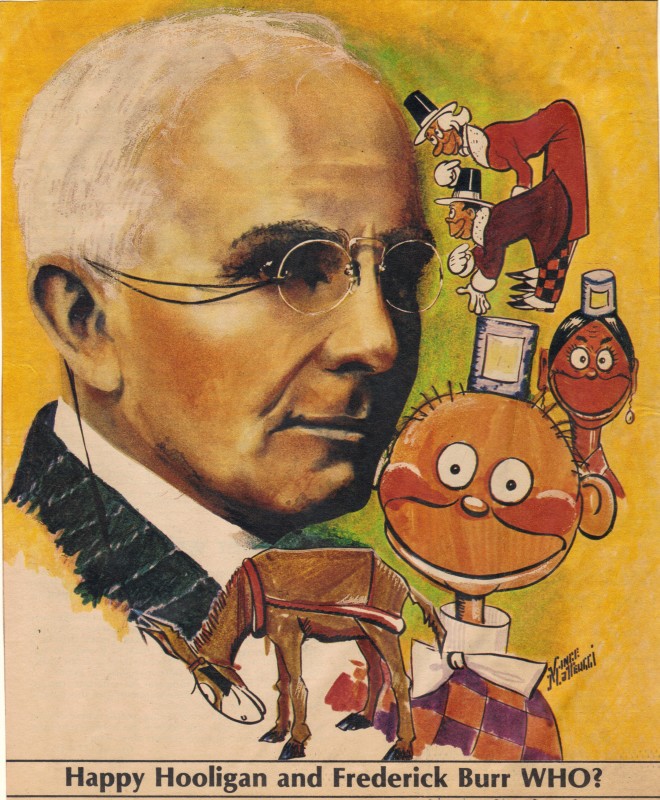 In addition to being known as the Mother of Presidents, Ohio might well be called the Mother of Cartoonists. Frederick Burr Opper of Madison in Lake County, Ohio, was a pioneer in syndicated cartoon illustration. Along with Ohioan Richard Felton Outcault, Opper was influential in the early development of the cartoon form in America.
In addition to being known as the Mother of Presidents, Ohio might well be called the Mother of Cartoonists. Frederick Burr Opper of Madison in Lake County, Ohio, was a pioneer in syndicated cartoon illustration. Along with Ohioan Richard Felton Outcault, Opper was influential in the early development of the cartoon form in America.
Newspaper illustrations had come into their own during the Civil War with the illustrations of Harper’s Weekly. Harper’s brought images of the news into people’s homes for the first time. Thomas “Frank” Beard (of the famous Beard family of artists who lived in Lake County) was an illustrator for Harper’s and was a contemporary of the famous Thomas Nast. Opper was inspired by Beard and others like him.
Born in 1857, Opper began drawing at the age of 14. He declared then that he wanted to become “a famous cartoonist.” Encouraged by the Beard brothers, Frank and Daniel Carter, he went to New York and started his future career by making window advertising cards. While working at this job, he tried his hand at humorous sketches. He wasn’t the only one who thought he had artistic ability. Wild Oats and other magazines bought some of his sketches, and his fame grew.
Opper began to illustrate for Puck, a well-known political magazine of the time. During this period, Opper expressed through his cartoons a leaning toward Progressivism, political philosophy that espouses the progress of the human condition through science, technology and social organization. American Progressivism was born out of the Gilded Age of American wealth, and its followers believe that economic disparity stifles human progress.
After illustrating for Puck, Opper began working for Hearst’s New York Journal, and his cartoons appeared in Hearst publications for thirty years. Opper’s first cartoon “strips” were “The Folks in Funnyville” and “Our Antediluvian Ancestors.” Both contained his own writing and pictures.
Opper developed a series of cartoons entitled “Willie and His Papa” for the New York Journal. These cartoons were probably the most influential cartoons of the presidential campaign of 1900. They pictured President McKinley as a child of the trusts; the head of McKinley was placed on the body of a little boy wearing a Little Lord Fauntleroy collar. “Papa” was a corpulent, diamond-studded character representing the trusts; Mark Hanna was the “Nursie.” The cartoon continued until McKinley’s assassination. Another of Oppers series presented President Roosevelt through a number of perilous hunting adventures. The President greatly enjoyed these friendly adventures, and wrote the artist a letter of appreciation.
Opper’s most famous character, “Happy Hooligan”, was a tramp with a little tin can for a hat whose gentle simplicity and bumbling good nature left him unwittingly open to injury by unscrupulous characters. Some critics have traced the origins of Charlie Chaplin’s Little Tramp to “Happy Hooligan”. Another achievement of Opper was that he is thought to have brought the technique of “balloon talk” to America with “Happy Hooligan.”
Other Opper creations are Maud the Mule in “Her Name is Maud” and “Alphonse and Gaston”. Maud was a mule who always got her revenge, and Alphonse and Gaston were two overly polite Frenchmen (“After you, my dear Alphonse!” “No, no! After you, my dear Gaston.”). He also illustrated Mark Twain, Bill Nye, and Finley Peter Dunne books.
Opper believed in creating characters of action and effort full of energy and full of life. His obituary read, “An old man died in New Rochelle, N.Y., Friday who contributed more to the entertainment – and occasional instruction – of more Americans than perhaps any other man of his generation. Yet his name is almost forgotten today. He was Frederick Burr Opper, dean of American comic artists.”
Frederick Opper’s cartoons will be featured in our new Elections Exhibits being installed in our South Wing and scheduled for a Grand Opening January 2016.
